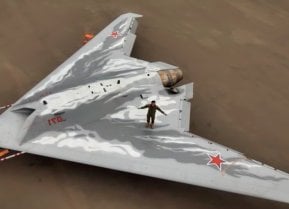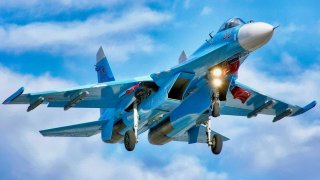Su-27 Flanker: Russia's Fighter Built to Destroy the F-15 Eagle
The Su-27 Flanker has been considered one of the best air superiority fighters of its time, and even today, it remains one of the most successful fighters in aviation history.
The Su-27 was designed for a battle with the F-15 fighter jet. And yet, while that never happened, the Su-27 has become a very powerful combat fighter for the old Soviet Union and now the Russian Federation:
Developed by the Soviet Union in the early 1970s, the Sukhoi Su-27 was meant to be Moscow’s answer to the F-15 Eagle. The Su-27 first entered service as an air superiority fighter.
Still, it has demonstrated considerable growth potential that included a variant for use as a carrier fighter, while the platform has become a proven export aircraft.
Sukhoi had first begun work on its T-10 design in 1969, and the goal was to create a highly agile fighter with long-range capabilities, heavy armament, and sophisticated sensors. To maximize the aircraft’s maneuverability, it was designed from the start to utilize a fly-by-wire (FBW) control system.
Development of the plane was slow going, and the first prototype didn’t make its maiden flight until May 1977. Moreover, in its initial form, the T-10 prototype aircraft displayed several serious deficiencies – so much so that a complete redesign was required. It reemerged as the radically reworked T-10S-1 in 1981.
The aircraft entered series production in 1982 as a single-seat multirole fighter and received the designation Su-27 (NATO reporting name “Flanker-B”).
Two years later, the two-seater version, the Su-27UB (NATO reporting name “Flanker-C”), was introduced. By the end of the Cold War, just over 400 Su-27s in both versions were produced for service with the Soviet Air Force.
Su-27: Post-Soviet Use
After the dissolution of the Soviet Union in late 1991, the “Flanker” remained the backbone of the Russian Air Force throughout the 1990s and early 2000s. Many aircraft underwent a mid-life upgrade, which transformed them into the re-designated Su-27SM.
The fighters were equipped with a new avionics fleet, and they were complemented by a small batch of newly built aircraft that also featured improved avionics and mission equipment. Those aircraft were designated the Su-27SM3.
In the 1990s, Moscow also began to produce the Flanker for foreign sales. Among the export models was the baseline Su-27SK, developed for China. It was similar to the Flanker-B but with additional air-to-ground capabilities.
In addition, China had also received the Su-27UBK, which was based on the Flanker-C.
After around eighty of the Russian-built aircraft were supplied to the People’s Liberation Army (PLA), Beijing began the production of a licensed version.
It built an additional ninety-five single-seat models, designated as the J-11, a version of the Su-27 that was reverse engineered that angered Russia to a great extent.
A variant, the Su-30MK, was sold to India with licensed local production.
The first of up to 140 aircraft indigenously built by Hindustan Aeronautics Ltd (HAL) was reportedly delivered in November 2004.
The Naval Flanker
Known as the Sukhoi Su-27K and the Su-33 (NATO reporting name “Flanker-D”), a specially-modified version of the aircraft developed for use on the Soviet Navy’s aircraft cruisers. It was first flown in August 1987. Compared to the Flanker-B, the Su-33 features an arrester hook, canard foreplanes, a folding tail “sting,” foldable wings, and tailplane, a strengthened twin nosewheel, modified flight control system, increased-area fin, and a retractable flight-refueling probe.
The weapons control systems of the Su-33 are otherwise similar to the baseline aircraft, which essentially restricted it to air defense missions.
The aircraft was only produced following the dissolution of the Soviet Union, by which time Moscow was cash-strapped, and production was cut short. The first batch of four Su-33s entered service in 1993.
By 1998, some twenty-four Flanker-D aircraft had been accepted by the Russian Naval Aviation service. It was primarily employed as a fighter aboard the Russian Navy’s sole carrier Admiral Kuznetsov.
Key Su-27 “Flanker-B” Specs:
Type of aircraft: All-weather air superiority fighter
Length: 71 feet, 10 inches (21.90m)
Wingspan: 48 feet, 2.75 inches (14.70m)
Height: 19 feet, 5.5 inches (5.93m)
Weight: 72,751 pounds (33,000 kg) maximum takeoff
Powerplant: Two 122.58kN (27,557 pounds) Saturn/Lyulka AL-31F afterburning turbofans
Maximum speed: 1,417 mph (2,280km/h) at 39,090 feet (11,000m)
Range: 2,287 miles (3680km) at high altitude
Service ceiling: 58,071 feet (17,700 m)
Armament: One 30mm (1.18inch) cannon and up to 6,000kg (13,228 pounds) including up to six medium-range and four short-range AAMs
The original Flanker-B/C production models could carry weapons on ten external hardpoints, including one on each of the wingtips, two under each wing, one under each engine, and two in tandem on the fuselage centerline.
The aircraft’s self-protection suite includes a radar warning receiver (RWR), a two-pod electronic countermeasure (ECM) suite, and chaff/flare dispensers.
The Su-27 has been considered one of the best air superiority fighters for its time, and even today, it remains one of the most successful fighters in aviation history.
About the Author
Peter Suciu is a Michigan-based writer who has contributed to more than four dozen magazines, newspapers and websites. He regularly writes about military hardware, and is the author of several books on military headgear including A Gallery of Military Headdress, which is available on Amazon.com. Peter is also a Contributing Writer for Forbes.


